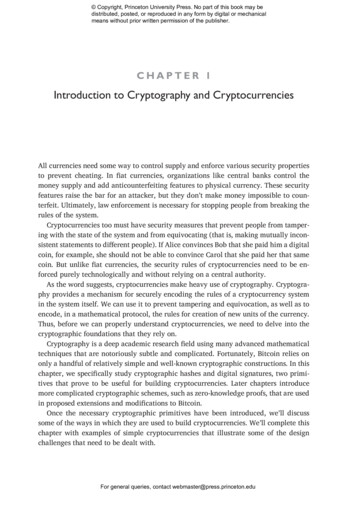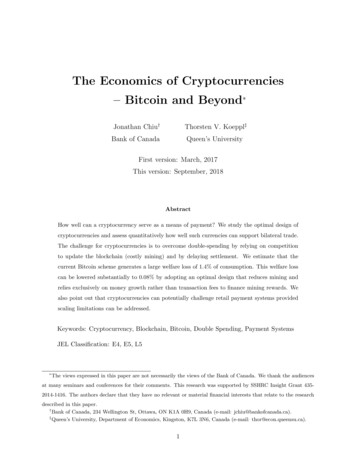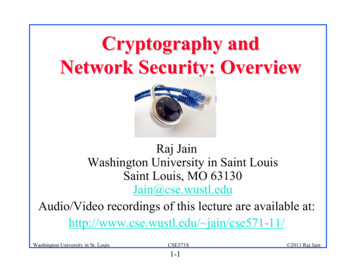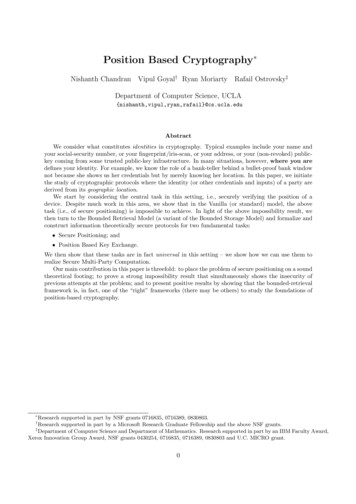
Transcription
Copyright, Princeton University Press. No part of this book may bedistributed, posted, or reproduced in any form by digital or mechanicalmeans without prior written permission of the publisher.CHAPTER 1Introduction to Cryptography and CryptocurrenciesAll currencies need some way to control supply and enforce various security propertiesto prevent cheating. In fiat currencies, organizations like central banks control themoney supply and add anticounterfeiting features to physical currency. These securityfeatures raise the bar for an attacker, but they don’t make money impossible to counterfeit. Ultimately, law enforcement is necessary for stopping people from breaking therules of the system.Cryptocurrencies too must have security measures that prevent people from tampering with the state of the system and from equivocating (that is, making mutually inconsistent statements to different people). If Alice convinces Bob that she paid him a digitalcoin, for example, she should not be able to convince Carol that she paid her that samecoin. But unlike fiat currencies, the security rules of cryptocurrencies need to be enforced purely technologically and without relying on a central authority.As the word suggests, cryptocurrencies make heavy use of cryptography. Cryptography provides a mechanism for securely encoding the rules of a cryptocurrency systemin the system itself. We can use it to prevent tampering and equivocation, as well as toencode, in a mathematical protocol, the rules for creation of new units of the currency.Thus, before we can properly understand cryptocurrencies, we need to delve into thecryptographic foundations that they rely on.Cryptography is a deep academic research field using many advanced mathematicaltechniques that are notoriously subtle and complicated. Fortunately, Bitcoin relies ononly a handful of relatively simple and well- known cryptographic constructions. In thischapter, we specifically study cryptographic hashes and digital signatures, two primitives that prove to be useful for building cryptocurrencies. Later chapters introducemore complicated cryptographic schemes, such as zero- knowledge proofs, that are usedin proposed extensions and modifications to Bitcoin.Once the necessary cryptographic primitives have been introduced, we’ll discusssome of the ways in which they are used to build cryptocurrencies. We’ll complete thischapter with examples of simple cryptocurrencies that illustrate some of the designchallenges that need to be dealt with.For general queries, contact webmaster@press.princeton.edu
Copyright, Princeton University Press. No part of this book may bedistributed, posted, or reproduced in any form by digital or mechanicalmeans without prior written permission of the publisher.2 C hapter 11.1. CRYPTOGRAPHIC HASH FUNCTIONSThe first cryptographic primitive that we need to understand is a cryptographic hashfunction. A hash function is a mathematical function with the following three properties: Its input can be any string of any size. It produces a fixed- sized output. For the purpose of making the discussion inthis chapter concrete, we will assume a 256- bit output size. However, our discussion holds true for any output size, as long as it is sufficiently large. It is efficiently computable. Intuitively this means that for a given input string,you can figure out what the output of the hash function is in a reasonableamount of time. More technically, computing the hash of an n- bit string shouldhave a running time that is O(n).These properties define a general hash function, one that could be used to build adata structure, such as a hash table. We’re going to focus exclusively on cryptographichash functions. For a hash function to be cryptographically secure, we require that ithas the following three additional properties: (1) collision resistance, (2) hiding, and(3) puzzle friendliness.We’ll look more closely at each of these properties to gain an understanding of whyit’s useful to have a function that satisfies them. The reader who has studied cryptography should be aware that the treatment of hash functions in this book is a bit differentfrom that in a standard cryptography textbook. The puzzle- friendliness property, inparticular, is not a general requirement for cryptographic hash functions, but one thatwill be useful for cryptocurrencies specifically.Property 1: Collision ResistanceThe first property that we need from a cryptographic hash function is that it is collisionresistant. A collision occurs when two distinct inputs produce the same output. A hashfunction H( ) is collision resistant if nobody can find a collision (Figure 1.1). Formally:Collision resistance. A hash function H is said to be collision resistant if it is infeasible to find two values, x and y, such that x y, yet H(x) H(y).Notice that we said “nobody can find” a collision, but we did not say that no collisions exist. Actually, collisions exist for any hash function, and we can prove this by asimple counting argument. The input space to the hash function contains all strings ofall lengths, yet the output space contains only strings of a specific fixed length. Becausethe input space is larger than the output space (indeed, the input space is infinite, whilethe output space is finite), there must be input strings that map to the same outputFor general queries, contact webmaster@press.princeton.edu
Copyright, Princeton University Press. No part of this book may bedistributed, posted, or reproduced in any form by digital or mechanicalmeans without prior written permission of the publisher.C ryptography and C ryptocurrencies 3xH(x) H(y)yFIGURE 1.1. A hash collision. x and y are distinct values, yet when input into hash function H, theyproduce the same output.string. In fact, there will be some outputs to which an infinite number of possible inputswill map (Figure 1.2).Now, to make things even worse, we said that it has to be impossible to find a collision. Yet there are methods that are guaranteed to find a collision. Consider the following simple method for finding a collision for a hash function with a 256- bit output size:pick 2256 1 distinct values, compute the hashes of each of them, and check whetherany two outputs are equal. Since we picked more inputs than possible outputs, somepair of them must collide when you apply the hash function.The method above is guaranteed to find a collision. But if we pick random inputs andcompute the hash values, we’ll find a collision with high probability long before examining 2256 1 inputs. In fact, if we randomly choose just 2130 1 inputs, it turns outthere’s a 99.8 percent chance that at least two of them are going to collide. That we canfind a collision by examining only roughly the square root of the number of possibleoutputs results from a phenomenon in probability known as the birthday paradox. In thehomework questions (see the online supplementary material for this book, which canbe found at http://press.princeton.edu/titles/10908.html), we examine this in moredetail.This collision- detection algorithm works for every hash function. But, of course, theproblem is that it takes a very long time to do. For a hash function with a 256- bit output, you would have to compute the hash function 2256 1 times in the worst case, andabout 2128 times on average. That’s of course an astronomically large number—if acomputer calculates 10,000 hashes per second, it would take more than one octillionPossible outputsPossible inputsFIGURE 1.2. Inevitability of collisions. Because the number of inputs exceeds the number of outputs,we are guaranteed that there must be at least one output to which the hash function maps more thanone input.For general queries, contact webmaster@press.princeton.edu
Copyright, Princeton University Press. No part of this book may bedistributed, posted, or reproduced in any form by digital or mechanicalmeans without prior written permission of the publisher.4 C hapter 1(1027) years to calculate 2128 hashes! For another way of thinking about this, we can saythat if every computer ever made by humanity had been computing since the beginningof the universe, the odds that they would have found a collision by now are still infinitesimally small. So small that it’s far less than the odds that the Earth will be destroyedby a giant meteor in the next two seconds.We have thus found a general but impractical algorithm to find a collision for anyhash function. A more difficult question is: Is there some other method that could beused on a particular hash function to find a collision? In other words, although the generic collision detection algorithm is not feasible to use, there may be some other algorithm that can efficiently find a collision for a specific hash function.Consider, for example, the following hash function:H(x) x mod 2256This function meets our requirements of a hash function as it accepts inputs of anylength, returns a fixed- sized output (256 bits), and is efficiently computable. But thisfunction also has an efficient method for finding a collision. Notice that this functionjust returns the last 256 bits of the input. One collision, then, would be the values 3 and3 2256. This simple example illustrates that even though our generic collision detection method is not usable in practice, there are at least some hash functions for whichan efficient collision detection method does exist.Yet for other hash functions, we don’t know whether such methods exist. We suspect that they are collision resistant. However, no hash functions have been proven tobe collision resistant. The cryptographic hash functions that we rely on in practice arejust functions for which people have tried really, really hard to find collisions andhaven’t yet succeeded. And so we choose to believe that those are collision resistant.(In some cases, such as the hash function known as MD5, collisions were eventuallyfound after years of work, resulting in the function being deprecated and phased outof practical use.)APPLICATION: MESSAGE DIGESTSNow that we know what collision resistance is, the logical question is: What is it usefulfor? Here’s one application: If we know that two inputs x and y to a collision- resistanthash function H are different, then it’s safe to assume that their hashes H(x) and H(y)are different—if someone knew an x and y that were different but had the same hash,that would violate our assumption that H is collision resistant.This argument allows us to use hash outputs as a message digest. Consider SecureBox,an authenticated online file storage system that allows users to upload files and to ensure their integrity when they download them. Suppose that Alice uploads really largefiles, and she wants to be able to verify later that the file she downloads is the same asthe one she uploaded. One way to do that would be to save the whole big file locally,and directly compare it to the file she downloads. While this works, it largely defeatsFor general queries, contact webmaster@press.princeton.edu
Copyright, Princeton University Press. No part of this book may bedistributed, posted, or reproduced in any form by digital or mechanicalmeans without prior written permission of the publisher.C ryptography and C ryptocurrencies 5the purpose of uploading it in the first place; if Alice needs to have access to a localcopy of the file to ensure its integrity, she can just use the local copy directly.Collision- resistant hashes provide an elegant and efficient solution to this problem.Alice just needs to remember the hash of the original file. When she later downloadsthe file from SecureBox, she computes the hash of the downloaded file and comparesit to the one she stored. If the hashes are the same, then she can conclude that the fileis indeed the same one she uploaded, but if they are different, then Alice can concludethat the file has been tampered with. Remembering the hash thus allows her to detectnot only accidental corruption of the file during transmission or on SecureBox’s servers but also intentional modification of the file by the server. Such guarantees in theface of potentially malicious behavior by other entities are at the core of what cryptography gives us.The hash serves as a fixed- length digest, or unambiguous summary, of a message.This gives us a very efficient way to remember things we’ve seen before and to recognize them again. Whereas the entire file might have been gigabytes long, the hash is offixed length—256 bits for the hash function in our example. This greatly reduces ourstorage requirement. Later in this chapter and throughout the book, we’ll see applications for which it’s useful to use a hash as a message digest.Property 2: HidingThe second property that we want from our hash functions is that it is hiding. The hidingproperty asserts that if we’re given the output of the hash function y H(x), there’s nofeasible way to figure out what the input, x, was. The problem is that this property can’tbe true in the form stated. Consider the following simple example: we’re going to do anexperiment where we flip a coin. If the result of the coin flip was heads, we’re going toannounce the hash of the string “heads.” If the result was tails, we’re going to announcethe hash of the string “tails.”We then ask someone, an adversary, who didn’t see the coin flip, but only saw thishash output, to figure out what the string was that was hashed (we’ll soon see why wemight want to play games like this). In response, they would simply compute both thehash of the string “heads” and the hash of the string “tails,” and they could see whichone they were given. And so, in just a couple steps, they can figure out what the inputwas.The adversary was able to guess what the string was because only two values of xwere possible, and it was easy for the adversary to just try both of them. To be able toachieve the hiding property, there must be no valu
CRYPTOGRAPHY AND CRYPTOCURRENCIES 3 string. In fact, there will be some outputs to which an infinite number of possible inputs will map (Figure 1.2).











